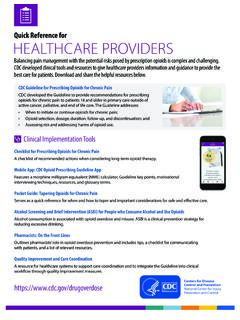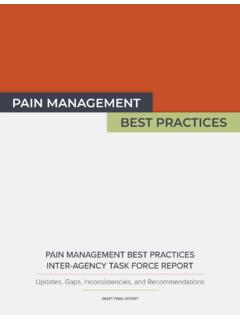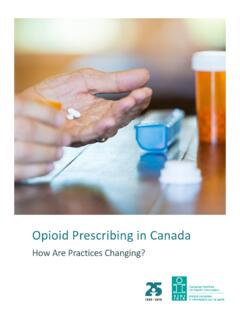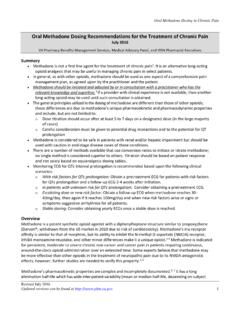Transcription of Pocket Guide: Tapering Opioids for Chronic Pain
1 Pocket guide : Tapering Opioids FOR Chronic pain * Follow up regularly with patients to determine whether Opioids are meeting treatment goals and whether Opioids can be reduced to lower dosage or discontinued. *Recommendations focus on pain lasting longer than 3 months or past the time of normal tissue healing, outside of active cancer treatment, palliative care, and end-of-life care. GUIDELINE FOR prescribing Opioids FOR Chronic pain WHEN TO TAPERWHEN TO TAPER Consider Tapering to a reduced opioid dosage or Tapering and discontinuing opioid therapy when your patient: requests dosage reduction does not have clinically meaningful improvement in pain and function ( , at least 30% improvement on the 3-item PEG scale) is on dosages 50 MME*/day without benefit or Opioids are combined with benzodiazepines shows signs of substance use disorder ( work or family problems related to opioid use, difficulty controlling use) experiences overdose or other serious adverse event shows early warning signs for overdose risk such as confusion, sedation, or slurred speech *morphine milligram equivalents HOW TO TAPER Tapering plans should be individualized and should minimize symptoms of opioid withdrawal while maximizing pain treatment with nonpharmacologic therapies and nonopioid medications.
2 In general: Go SlowA decrease of 10% per month is a reasonable starting point if patients have taken Opioids for more than a year. A decrease of 10% per week may work for patients who have taken Opioids for a shorter time (weeks to months). Discuss the increased risk for overdose if patients quickly return to a previously prescribed higher dose. Coordinate with specialists and treatment experts as needed especially for patients at high risk of harm such as pregnant women or patients with an opioid use disorder. Use extra caution during pregnancy due to possible risk to the pregnant patient and to the fetus if the patient goes into withdrawal. Make sure patients receive appropriate psychosocial support. If needed, work with mental health providers, arrange for treatment of opioid use disorder, and offer naloxone for overdose prevention. Watch for signs of anxiety, depression, and opioid use disorder during the taper and offer support or referral as needed.
3 Patient collaboration and buy-in are important to successful Tapering . Tell patients that improved function and decreased pain after a taper can be expected, even though pain might ConsultSupportEncourageinitially get worse. Tell patients I know you can do this or I ll stick by you through this. Department of Health and Human ServicesCenters for Disease Control and prevention CONSIDERATIONS Avoid abrupt Tapering or sudden discontinuation of Opioids . Once lowest available dose is reached, the interval between doses can be extended. If discontinuing Opioids , they may be stopped when taken less than once a day. Adjust the rate and duration of the taper according to the Don t reverse the taper; however, the rate may be slowed or patient s response. paused while monitoring and managing withdrawal symptoms. AssessAdjustMonitorWeigh the benefits and risks of Opioids .
4 Use clinical judgment and patient information to make decisions about whether to continue at the current dosage, taper and continue at a lower dosage, or taper and discontinue opioid therapy. CDC Guideline for prescribing Opioids for Chronic pain CDC opioid prescribing Guideline Mobile App Tapering Long-Term opioid Therapy in Chronic Noncancer pain (15)00303-1/fulltext RESOURCES.
















